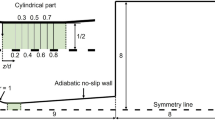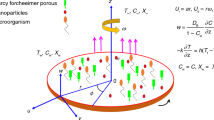Abstract
Modified variants of differential turbulence models which make it possible continuously to calculate both the entire flow region with laminar, transition and turbulent regimes and local low Reynolds number zones are proposed for investigating the flow and heat transfer in the boundary layers developing in compressible gas flow past curvilinear airfoils. The effect of the intensity and scale of free-stream turbulence and their variability along the outer boundary layer edge, as well as the combined action of the turbulence intensity and the streamwise pressure gradient in flow past blade profiles, on the heat transfer and near-wall turbulence characteristics is analyzed. The numerical results are compared with experimental and theoretical data.
Similar content being viewed by others
References
H. L. Dryden, “Transition from laminar to turbulent flow,” in: Turbulent Flow and Heat Transfer, Princeton Univ. Press, N. Y. (1959), P. 3.
G. S. Glushko, “Transition to the turbulent flow regime in the boundary layer on a flat plate for various free-stream turbulence scales,” Izv. Akad. Nauk SSSR, Mekh. Zhidk. Gaza, No. 3, 68 (1973).
V. M. Kapinos, A. F. Slitenko, and V. B. Titov, “Experimental investigation of the turbulent flow and local heat transfer characteristics in airfoil cascades,” in: Heat and Mass Transfer — VI: Proceedings of 6th All-Union Conference on Heat and Mass Transfer, Vol. 1 [in Russian], Heat and Mass Transfer Institute, Minsk (1980), p. 122.
V. D. Sovershennyi, “Equations of turbulent flow,” Izv. Akad. Nauk SSSR, Mekh. Zhidk. Gaza, No. 4, 31 (1984).
V. G. Lushchik, A. A. Pavelev, and A. E. Yakubenko, “Investigation of turbulent transition in a boundary layer for high-intensity external perturbations by means of the three-parameter model,” in: Problems of Modern Mechanics, Vol. 1 [in Russian], Moscow University Press, Moscow (1983), P. 127.
A. S. Ginevskii, V. A. Ioselevich, A. V. Kolesnikov et al., “Methods for calculating the turbulent boundary layer,” in: Advances in Science and Engineering. Fluid Mechanics, Vol. 11 [in Russian], VINTTl, Moscow (1978), P. 155.
V. C. Patel, W. Rodi, and G. Schenerer, “Turbulence models for near-wall and low Reynolds number flows: A review,” AIAA J., 23, 1308 (1985).
Y. Nagano, M. Nishida, and T. Asano, “Improved form of the Al-e-model for wall turbulent shear flows,” Trans. Jap. Soc. Mech. Eng., B50, No. 457, 2022 (1984).
W. P. Jones and V. E. Launder, “The calculation of low-Reynolds-number phenomena with a two-equation model of turbulence,” Intern. J. Heat and Mass Transfer, 16, 1119 (1973).
J. C. Rotta, “Statistische Theorie nichthomogener Turbulenz,” Z. Phys., Mitt. 1, 129, 547; Mitt. 2, 131, 51 (1951).
S. Hassid and M. Poreh, “A turbulent energy model for flow with drag reduction,” Trans. ASME, Ser. I. J. Fluids Eng., 97, ITA (1975).
E. R. Van Driest, “On turbulent flow near a wall,” J. Aeronaut. Sci., 23, 1007 (1956).
V. D. Sovershennyi and V. A. Aleksin, “Calculation of a boundary layer over airfoils in the presence of laminar and turbulent flow regime zones,” Izv. VUZov, Aviats. Tekhnika, No. 2, 68 (1983).
K.-Y. Chien, “Predictions of channel and boundary-layer flows with a low-Reynolds-number turbulence model,” AIAA J., 20, 33 (1982).
B. J. Abu-Ghannam and R. Shaw, “Natural transition of boundary layers — the effect of turbulence, pressure gradient, and flow history,” J. Mech. Engng. Sci., 22, No. 5, 213 (1980).
F. S. Lien and M. A. Leschiner, “A general nonorthogonal finite-volume algorithm for turbulent-flow at all speeds incorporating second-moment turbulence-transport closure. Pt. 1: Computational implementation,” Comput Method. Appl. Mech. Eng., 114, 123 (1994).
W. C. Strahle, “Stagnation point flows with freestream turbulence-the matching conditions,” AIAA J., 23, 1822 (1985).
A. M. Savill (Ed.), Transition Modelling for Turbomachinery II: An Updated Summ. of ERCOFTAC Trans. SIG Progr. 2nd Workshop, University Press, Cambridge (1994).
R. D. Zerkl and R. D. Lansbury, “Influence of free-stream turbulence on heat transfer to turbine blades,” J. Propulsion, No. 1, 82 (1989).
M. E Blair, “Influence of free-stream turbulence on boundary layer transition in favorable pressure gradients,” Trans. ASME, J. Engng for Power, 104, 743 (1982).
Rights and permissions
About this article
Cite this article
Aleksin, V.A. Simulation of the Effect of the Freestream Turbulence Parameters on the Boundary Layer of a Curvilinear Airfoil. Fluid Dyn 33, 701–709 (1998). https://doi.org/10.1007/BF02698619
Published:
Issue Date:
DOI: https://doi.org/10.1007/BF02698619




